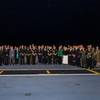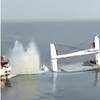Retooling the U.S. Coast Guard
Small Boat(s), Big mission(s), Uncertain funding(?)
Under the Radar and also the higher profile Fast Response (FRC) and National Security Cutter (NSC) acquisitions is the U.S. Coast Guard’s effort to replace and upgrade its fleet of smaller response workboats. The building programs involve big money and substantial innovation. But, for all the progress being made, the failure of the federal government to come to a budget deal for the coming fiscal year could also put the brakes on some of the most innovative programs that the Coast Guard has ever embarked upon. In the meantime, it is full speed ahead with a three-pronged small boat program that could eventually involve as many as 650 vessels.
The effort to recapitalize the Coast Guard never ends. And, although the larger cutter programs tend to get the most attention from industry observers, the job of making sure that the workhorse small boat response fleet for the nation’s homeland security stalwart remains up to the task is arguably more important. Starting in 2002, the U.S. Coast Guard purchased 100 RB-HS boats from U.S. builder Safe Boats, followed by another larger purchase of 448 RB-S I boats during the period of 2003 through 2009. Today, the effort to replace these and other aging assets and at the same time, standardize the Coast Guard’s response boat platforms across the breadth of the organization is also well underway.
Contract Awards
At least three major contracts have been awarded and production is underway on boat awards. The first award involves Metal Shark Aluminum Boats of Jeanerette, LA and a fixed price contract to replace the U.S. Coast Guard’s fleet of Response Boat – Small (RB-S) vessels. As many as 470 boats could eventually be delivered to the Coast Guard, with another 30 boats potentially to be built for the U.S. Customs and Border Protection and the U.S. Navy. The $192 million contract – one of the largest boat buys of its kind ever for the Coast Guard – will greatly enhance its mission capabilities in the years to come.
For the Response Boat – Medium (RB-M) requirements, the Coast Guard has awarded to Marinette Marine Corporation contract(s) for as many as 166 boats that may eventually reach an expenditure of almost $400 million. The most recent delivery order of 40 boats was made in February; a $90 million addition to the current backlog.
Finally, DHS in June also awarded a Firm Fixed-priced, Indefinite Delivery Indefinite Quantity contract to MetalCraft Marine US, Inc. of Clayton, NY. That deal calls for up to ten Cutter Boat Long Range Interceptor II’s (CB-LRI-II) that will deploy from USCG National Security Cutters.
Metal Shark’s Response Boat-Small (RB-S) II
The Response Boat-Small (RB-S) is intended to perform a myriad of missions for the Coast Guard, including but not limited to Ports, Waterways, and Coastal Security (PWCS), Search and Rescue (SAR), Drug Interdiction (DRUG), Alien Migrant Interdiction Operations (AMIO), Living Marine Resources (LMR), Defense Readiness (DR) and Other Law Enforcement (OLE) missions. Under a phased, competitive procurement, the initial contract award called for Metal Shark and another contractor to produce one boat each. The Coast Guard then exercised a delivery order valued at approximately $13 million on September 26, 2011 to Metal Shark Aluminum Boats for the production of 38 units. Eventually and in August of this year, the Coast Guard placed a second delivery order with Metal Shark for another 25 boats – valued at $8.1 million – and this brought the total number of boats on order to 63.
The U.S. Coast Guard took delivery of the first new Response Boat-Small (RB-S) II in June. Eventually, it is intended that the RB-S II will replace the Defender-class RB-S, of which there are more than 400 still in service. And, because the Defender-class RB-S is the largest vessel class in the Coast Guard fleet, this replacement program is especially important. In the choppy wake of other Deepwater recapitalization failures, the Coast Guard wants to get this one right. So far, it looks like they are on the right track.
The new RB-S II has a length of 29 feet, and is powered by twin 225-horsepower (hp) Honda outboards producing a top speed of over 45 knots with a range of 150 nautical miles. The turnkey delivered boats all come with their own Evolution, Patriot Series trailers.
Outfitted with a standardized communications and navigation suite and designed to improve functional design and crew comfort, the RB-S II will be operated by a crew of four. RB-S is also weapons-ready, with multiple weapons racks and an integrated weapons-ready mounting system at the bow. The forward-mounted gunner’s platform provides 180-degree firing capability while a pass-through hatch leads to the cabin for easy access in any conditions.
According to Metal Sharks’ Greg Lambrecht, a deciding factor in the Coast Guard’s decision to choose the Metal Shark entry had to do with the superior visibility of their convertible cabin arrangement. Lambrecht explained, “The cabin provides innovative protection, but is able to be opened up for safety. With this arrangement, the Coast Guard will be able to operate the RB-S II in significant sea states, from Key West August as well as Minnesota in December.” Lambrecht added that the Coast Guard looked hard at “total ownership” cost when they chose the Metal Shark entry. For example, he said, the RB-S II gets good fuel economy in comparison to other hulls of the same size.
Metal Shark has fully ramped up to produce the boat in volume, beefing up their workforce by 30% to at the current level of about 130 employees, in order to produce about one boat weekly. To better manage the increased workload, Metal Shark is also expanding its 65,000-square-foot manufacturing facility in Jeanerette.
Marinette Marine Corporation’s Response Boats-Medium (RB-M)
A total of 81 RB-Ms have been delivered to Coast Guard stations around the country since March of 2008. Today, the RB-M has entered full-rate production, with at least 30 boats per year being delivered, or more than one boat every two weeks.
Designed to meet Coast Guard multi-mission requirements for search and rescue; ports, waterways and coastal security; drug interdiction; and migrant interdiction, the RB-M replaces the Coast Guard’s aging class of 41-foot Utility Boats and other large nonstandard boats with standardized assets more capable of meeting the Coast Guard’s requirements. The new, slightly larger 45-foot Response Boat-Medium (RB-M) boasts new ergonomics, enhanced safety features, and is part of the Coast Guard’s plan to standardize and revitalize its shore-based boat fleet.
The Coast Guard further hopes to improve its safety record by standardizing across the entire fleet to give operators one platform of this type to accomplish their mission set; not five or six. In a nutshell, the RB-M project delivered a new boat with significantly increased speed and performance, improving response time and agility for missions. The boats also are designed with human factors systems engineering concepts in mind, decreasing crew fatigue on extended patrols.
Also according to the Coast Guard, the RB-Ms provide greater effectiveness in search and rescue missions and are a more capable platform for enforcement of laws and treaties; ports, waterways and coastal security; defense operations; recreational boating safety; and marine environmental protection missions. Interoperability of the RB-Ms with other Coast Guard assets greatly enhances the Coast Guard’s command and control in the conduct of its missions.
Delivery of the latest award of 40 boats is scheduled to begin in the second quarter of 2013. This brings the total number of boats under contract to 166. Marinette Marine will build 50% of the boats at its ACE Marine facility in Green Bay, WI. MMC’s Teaming Partner, Kvichak Marine Industries of Seattle, will build the other 50% of the boats at its Kent, WA facility. Chuck Goddard, President and CEO of Marinette Marine said recently, “Marinette Marine looks forward to continuing its strong partnership with the US Coast Guard. They are a valued customer, and we are proud to build an additional 40 RB-Ms in support of their mission requirements.”
MetalCraft Marine’s US Coast Guard 35’ Long Range Interceptor-II
Simply put, the US Coast Guard 35’ Long Range Interceptor contract in conjunction with BCGP will be the largest contract in MCM US’s history. The first US Coast Guard 35’ Long Range Interceptor-II is currently under construction at MetalCraft Marine US Inc. Building on the success of the Sentry demo boat, MetalCraft Marine US Inc. and Brunswick Commercial and Government Products jointly prepared a proposal that offered the best value to the US Coast Guard, winning the contract to design and build ten 35’ Long Range Interceptor over the next five years. The $10.2 million contract calls for a boat that, unlike the RB-S and RB-M, will deploy from USCG National Security Cutters. The boat, referred to by the Coast Guard as the CB-LRI-II, is a multi-mission asset supporting Other Law Enforcement (OLE), National Defense (ND), Drug Interdiction (DRUG), Alien Migrant Interdiction Operations (AMIO), Living Marine Resources (LMR), Search and Rescue (SAR), and Ports, Waterways, and Coastal Security (PWCS) missions. Parent cutters can deploy the CB-LRI-II at sea anywhere in the world, day and night, in varying sea and weather conditions. To date, none have been delivered, with the first under construction and due to be delivered in December of 2012.
More than Acquisition: Strategy
The Coast Guard’s effort to upgrade all three of the platforms described in this article is no accident. Increasingly, and as the scourge of piracy grips worldwide shipping and the threat of terrorism looms closer to home, it is also becoming obvious that the role of the traditional 400’ cutter asset is slowly being supplanted by smaller, more agile vessels. In this case, the Coast Guard has done its homework.
Taking into consideration what the Coast Guard calls “total ownership costs,” metrics such as maintenance costs (standardization can reduce the cost of stockpiling parts), safety (standardization makes crew familiarization an easier task), and interoperability (tying all assets together as one through better communications and electronics), the DHS small craft acquisition strategy has reached a new level of sophistication. The changes do not come cheaply, but by amortizing the replacement costs up front, the Coast Guard hopes to save significantly more money over time.
Also looming over the entire effort is the state of the federal budget mess, where the “S” word – sequestration – is on everyone’s mind, but rarely spoken in the boatyards. That’s because unless a budget deal is reached soon, sequestration could reduce FY-13 expenditures even further. Privately, one contractor told MarineNews in October, “We may get all of the intended contracts for 2013, or we might get just one. We just don’t know, and neither does the Coast Guard.” In the meantime, DHS and its homeland security arm, the U.S. Coast Guard, need these new assets desperately. For their part, the boatyards hedge their bets by delivering an increasing number of hulls to foreign buyers, proof that U.S. builders can compete – in the right global market. For now, however, the biggest prize awaits here at home.
(As published in the November 2012 edition of Marine News - www.marinelink.com)













